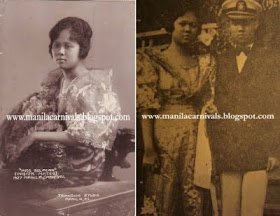
Perhaps, Anita Noble’s winning qualities set a standard that was too high to be matched by her would-be successor, so much so that in the next year’s Carnival edition, the local carnival committee opted not to send a delegate to the 2nd National Beauty Show of 1927, to the consternation of many who had expected to see another strong candidate from the province. Besides, it was a tall order for another Batangas beauty to win the crown two years in a row.
Instead, the local provincial carnival committee decided to focus their energy on their search for the 1928 Miss Batangas. This time, an appropriate grand event was planned that will be the backdrop for the proclamation of the province’s royal queen—the 1928 Batangas Carnival.

Sure enough, the search for Miss Batangas drew accomplished beauties from all over. There was Iluminada “Luming” Perez from Bolboc, who was already a popular Manila colegiala, and Consuelo Luna, the youngest daughter of Don Remigio Luna, an affluent businessman who had set up a lucrative pawn shop business in Batangas.

In the end, the title of Miss Batangas 1928 went to the fashionable Consuelo. But alas, that year, the 1928 Manila Carnival was scrapped for reasons still unclear, and with it, the national beauty pageant. Consuelo lost the opportunity to represent her province in the much-awaited beauty tilt.
 Luming Perez, the Diwata ng Bolboc, was luckier, because the year after, she was elected “Miss Centro Escolar de Señoritas” , the muse of the Manila school she went to. She became the school bet to the 1929 Miss Philippines search, which had attracted contestants from colleges, universities and other educational institutions. Iluminada eventually won a place in the court of Pacita de los Reyes, a law student of U.P., who snagged the Miss Philippines title.
Luming Perez, the Diwata ng Bolboc, was luckier, because the year after, she was elected “Miss Centro Escolar de Señoritas” , the muse of the Manila school she went to. She became the school bet to the 1929 Miss Philippines search, which had attracted contestants from colleges, universities and other educational institutions. Iluminada eventually won a place in the court of Pacita de los Reyes, a law student of U.P., who snagged the Miss Philippines title.
As for Consuelo Luna, she met and married a doctor ten years her senior, who had studied and taught at the University of the Philippines and Cambridge, England. As Mrs. Narciso Cordero, she settled in Quiapo, Manila where she and her husband started a family that consisted of two daughters, Gilda and Teresa. Gilda Cordero-Fernando is a respected figure in Philippine journalism today, an acclaimed and multi-awarded writer, editor, book publisher, artist and cultural advocate.
It would be another five years before another beauty of Batangas descent would wear the Miss Philippines sash. Half-Batangueña Maria Villanueva Kalaw, whose father Teodoro hails from Lipa, became Miss Philippines of 1931.









